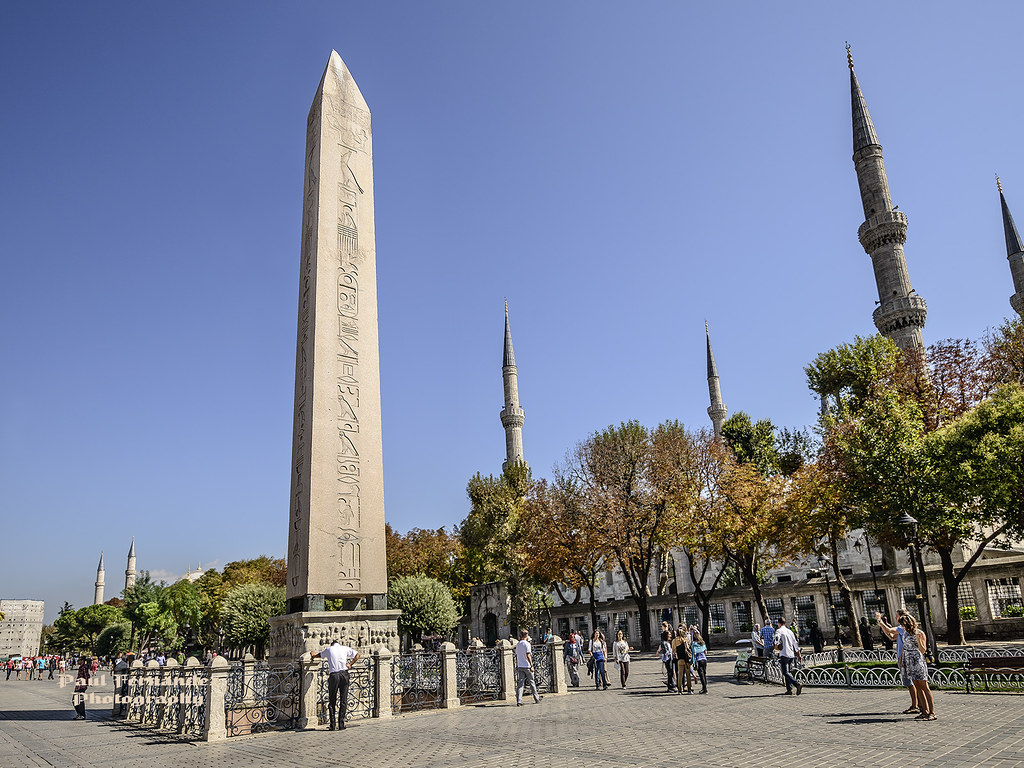Pay Once and Have Free Attractions Entry for 2, 3, 5 or 7 days
Embark on a journey through time and history as you explore Sultanahmet Square, the heart of Istanbul’s historic peninsula. Once the epicenter of Byzantine and Ottoman empires, this mesmerizing site continues to captivate travelers with its enchanting blend of ancient landmarks, intriguing stories, and lively atmosphere. From the awe-inspiring relics of the Byzantine Hippodrome to the architectural wonders that surround the square, let us be your guide to the must-see sights, hidden gems, and insider tips for a memorable visit to this iconic destination in Istanbul.

A History of Sultanahmet Square and the Byzantine Hippodrome
The Hippodrome of Constantinople
Sultanahmet Square, also known as the Hippodrome, was once the bustling heart of Byzantine Constantinople, serving as a public arena for chariot races, gladiatorial games, and various ceremonies. The foundations of the Great Palace of Constantinople, which connected to the Hippodrome, now lie beneath the Blue Mosque and can be seen at the Museum of the Great Palace Mosaics.
The Roman Influence and Constantinople’s Transformation
The Roman Emperor Septimius Severus first established the Hippodrome when he conquered ancient Byzantion in 203 CE, renaming the city Augusta Antonina. Emperor Constantine I later declared Constantinople as the capital of the Byzantine Empire in 330 CE, expanding the Hippodrome and leaving a lasting impact on the city’s architecture and culture.
Read also: Istanbul Ruines and Constantinople Sites: A Journey Through Byzantine History
Top Attractions and Unmissable Monuments
The Famous Monuments Trio: A Testament to Time
Three ancient monuments grace the heart of Sultanahmet Square: the Egyptian Obelisk, the Serpentine Column, and the Colossus, or Column of Constantine Porphyrogenitus. These remarkable structures have withstood the test of time and now offer a glimpse into the rich history of the Hippodrome and the chariot races that once took place here.
The Egyptian Obelisk
This impressive monument, dating back to 1450 BC, was brought to Constantinople from Egypt in 390 CE. The obelisk stands on a marble pedestal adorned with detailed reliefs depicting Emperor Theodosius I and spectators watching the races.

The Serpentine Column
An unusual talisman brought from the Delphi Temple in Apollo to protect the city from insect invasions, the Serpentine Column features three intertwined snakes with severed heads. The remaining snake head can be viewed at the Istanbul Archaeology Museums.
The Colossus
This 32-meter column, which once marked the turning point for chariot races, has lost its original brass plates and bronze sphere but remains an imposing sight within the square.
Don’t Miss The Best Tours and Cruises in Istanbul
Enjoy a Free Hippodrome of Constantinople Guided Tour with Istanbul E-Pass
The Istanbul E-Pass is a valuable option for travelers, as it offers a free Hippodrome of Constantinople guided tour, along with 50+ other attractions, providing a convenient and cost-effective way to explore the city.
Architectural Wonders Surrounding Sultanahmet Square
Visitors to the square can marvel at the architectural masterpieces that have made Istanbul famous, including the Blue Mosque, Hagia Sophia Museum, and the Museum of Turkish and Islamic Arts.

Blue Mosque (Sultanahmet Mosque)
This 17th-century mosque, adorned with exquisite blue Iznik tiles, is a stunning example of Turkish and Islamic architecture. Read more…
Hagia Sophia Museum
Once a church and a mosque, the Hagia Sophia Museum dates back to 325 and showcases the convergence of Byzantine and Islamic influences on Istanbul’s architecture. Read more…
Museum of Turkish and Islamic Arts
Housed in the historic Ibrahim Pasha Palace, this museum features a vast collection of artifacts spanning various mediums and periods. Read more…
Hurrem Sultan Hamam
Visitors should also explore the Hurrem Sultan Hamam, a historic Turkish bath designed by the famous Ottoman architect Sinan. The bath was constructed in the mid-16th century at the request of Hurrem Sultan, the wife of Sultan Suleiman the Magnificent. Today, visitors can enjoy a range of traditional hamam experiences and massage therapies at the bath, which also has a charming outdoor café and restaurant.

German Fountain
Another notable attraction in Sultanahmet Square is the German Fountain, also known as the Fountain of Kaiser Wilhelm II. This beautiful fountain was a gift from the German Emperor Wilhelm II to Sultan Abdul Hamid II in 1898 and is an excellent example of neo-Byzantine architecture. The fountain’s design includes eight marble columns supporting a dome, with four winged lions sitting atop the dome.
Don’t Miss Historical Background: Try Walking Tours
Amazing Facts about the Hippodrome of Constantinople
The Hippodrome of Constantinople has a rich history that spans centuries. Here are some incredible facts about this iconic attraction:
- The Serpent Column, one of the three monuments in the Hippodrome, was brought to Constantinople from the Temple of Apollo at Delphi in Greece. The column originally had three heads of snakes, but two of them were removed over time. Today, the only remaining snake head is on display at the Istanbul Archaeology Museums.
- During the Nika Riots in 532 CE, tens of thousands of people were killed in the Hippodrome by order of Byzantine Emperor Justinian I. The riot was sparked by a dispute between rival political factions, the Blues and the Greens, and quickly turned violent.
- The Hippodrome was a popular venue for chariot races during the Roman and Byzantine periods. The races were often accompanied by elaborate festivities and were a significant part of Constantinopolitan life.
- The Obelisk of Theodosius, located in the center of the Hippodrome, is one of the oldest surviving monuments in Istanbul. The obelisk was originally erected in Egypt in the 15th century BC and was brought to Constantinople in the 4th century CE.
- The Hippodrome was also used for other events, including public executions, gladiatorial games, and imperial ceremonies.
How to Get to Sultanahmet Square
Sultanahmet Square is located in the heart of Istanbul’s historic district and is easily accessible by public transportation. The easiest way to get to the square is by taking the tram to Sultanahmet, which is just a short walk away from the square. The T1 tram line runs along the Bosphorus and is a scenic way to reach the area. See the location >>
Visiting Sultanahmet Square: Insider Tips
To make the most of your visit to Sultanahmet Square, here are some insider tips to keep in mind:
- Consider visiting on a weekday (except Monday when Hagia Sophia is closed) rather than a weekend to avoid crowds.
- If you plan to visit the mosques in the area, make sure to dress appropriately. Women should cover their heads and wear long skirts or pants, while men should wear long pants and avoid shorts.
- Take a guided tour of the area to get a deeper understanding of the history and significance of the attractions.
- Plan to spend at least a few hours exploring the area to fully appreciate all that it has to offer.
Conclusion
Sultanahmet Square is a must-visit destination for anyone traveling to Istanbul. The square is steeped in history and is home to some of the city’s most iconic attractions, including the Blue Mosque, Hagia Sophia, and the Hippodrome. Visitors can easily spend a full day exploring the area and taking in the sights and sounds of this vibrant part of Istanbul. Whether you are a history buff, a culture lover, or simply looking for a beautiful place to explore, Sultanahmet Square is the perfect destination.
Visitor Information
-
💵
Entrance Fee: Free
-
⌛Opening Hours: 24 hours
-
⛔
Closed: No
-
📍
Location: Binbirdirek, Sultan Ahmet Parkı No:2, 34122 Fatih/İstanbul
You Might Be Interested in
- Best Food Delivery Apps in Istanbul: How to Order Food In
- Istanbul in May: Weather & Things to Do, Events in 2024
- April Weather in Istanbul: The Ultimate Guide for Travelers (2024)
- How to Make Turkish Coffee: Step-by-Step Recipe
- Explore Maltepe in Istanbul (Asian Side): Things to Do & See, Hotels, Restaurants (2024)
- Traveling in Istanbul with a Baby: Places to See and Tips for a Pleasant Vacation
- Istanbul Ruines and Constantinopol Sites: A Journey Through Byzantine History
- Galata Tower in Istanbul: Entrance Fee, Opening Hours, History & What to See (2024)
- Istanbul Archaeological Museums: Museums, Tickets, Opening Hours (2024)
- 8 Best Taksim Square Hotels in Istanbul from Luxury to Budget (2024)
Don’t Miss The Best Tours and Cruises in Istanbul